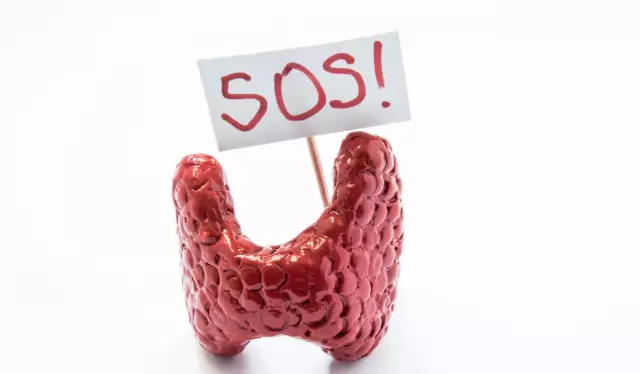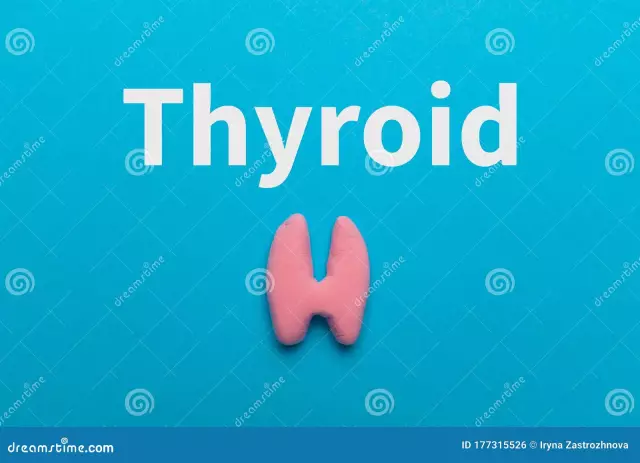- Author Rachel Wainwright [email protected].
- Public 2023-12-15 07:39.
- Last modified 2025-11-02 20:14.
Thyroid hypoplasia
The content of the article:
- Causes and risk factors
- The degree of the disease
- Symptoms
- Features of the course of the disease in children
- Diagnostics
- Treatment
- Possible complications and consequences
- Forecast
- Prevention
Hypoplasia of the thyroid gland is an underdevelopment of the thyroid gland, which is accompanied by a slowdown in the growth of its tissues and a violation of the production of hormones. It manifests itself as a violation of the development of one or another part of the gland (for example, hypoplasia of the left or right lobe) or a diffuse decrease in the size of the organ. Hypoplasia of the thyroid gland is a congenital pathology. With acquired changes of a similar nature, we are talking about hypotrophy of the thyroid gland, this condition can develop at any age.
The thyroid gland is an organ of internal secretion, which consists of two lobes connected by a narrow isthmus, accumulates iodine and produces iodine-containing hormones. The gland is located under the larynx (under the thyroid cartilage) in front of the trachea.
The thyroid gland produces two thyroid hormones (triiodothyronine and thyroxine), which have general physiological properties and are distinguished by the presence or absence of an additional iodine atom in the molecule. The target organs of these hormones are almost all structures of the body. Thyroid hormones increase blood pressure, heart rate, stimulate growth and development of the body, increase blood glucose levels, stimulate gluconeogenesis in the liver, erythropoiesis in the bone marrow, affect water metabolism, etc.
Hypoplasia is one of the rarest diseases of the thyroid gland.

Causes and risk factors
Hypoplasia of the thyroid gland is a congenital malformation that occurs as a result of the influence of unfavorable exogenous and / or endogenous factors on the body of a pregnant woman. According to a number of studies, there is a hereditary predisposition to thyroid hypoplasia. One of the common causes is a genetic mutation. The pathological process can develop against the background of thyroiditis, hypothyroidism, iodine deficiency in the body of a pregnant woman. Among the main factors are:
- anomalies of the primary germ cell formation;
- decrease in the amount of amniotic fluid;
- malposition;
- trauma;
- exposure to the body of a pregnant woman of high temperature, chemical compounds, radiation;
- infectious processes during pregnancy;
- taking hormonal drugs;
- drinking alcoholic beverages, smoking during pregnancy.
Hypotrophy of the thyroid gland in an adult can be caused by dysfunctions of the pituitary and hypothalamus, benign or malignant neoplasms, autoimmune diseases, pressure of neighboring structures on the thyroid gland, insufficient tissue oxygen supply, alcoholism, long-term intake of thyreostatic drugs, excessive intake of iodine or radioactive drugs, treatment with iodine hormone-containing drugs.
The degree of the disease
Allocate hypoplasia of the thyroid gland of the first, second and third degree.
Symptoms
Mild thyroid hypoplasia may not have pronounced clinical manifestations.
The presence of diffuse hypoplasia of the thyroid gland in adults leads to the development of cardiac disorders. The size of the heart of patients gradually increases, which is accompanied by the accumulation of fluid in the pericardial cavity. Against the background of heart failure, chronic renal failure occurs, disruption of the gastrointestinal tract. With hypoplasia of the thyroid gland in women, the functions of the reproductive system are disrupted, up to infertility.
As the malnutrition of the pathological process progresses, patients develop myxedema edema (accumulation of mucus-like fluid in the body cavities), which are manifested by smoothing out the contours of the face, edema of the eyelids. Swelling of the mucous membranes of the nasopharynx leads to breathing disorders, edema of the middle ear causes the development of hearing impairment. In addition, in patients, the heart rate decreases, there is pallor of the skin, cooling of the extremities.
Features of the course of the disease in children
With hypoplasia of the thyroid gland in children, the first symptoms usually appear in 2-3 months. Attention is drawn to lethargy, apathy, drowsiness, lethargy or complete lack of response to stimuli (light, sound), decreased appetite, weight loss, hoarseness, regular constipation, and in some cases, prolonged jaundice. From 4-5 months, a lag in physical development becomes noticeable. At a later age, pronunciation is impaired. With the progression of the pathological process and the absence of adequate treatment against the background of insufficient production of thyroid hormones, cretinism may develop, which is manifested by a pronounced lag in mental development and serious neurological disorders. Outward signs of cretinism are short stature, disproportionate physique,excessively large head, depressed bridge of the nose, squint. The navel is usually low, the abdomen is protruding, the genitals are underdeveloped, the voice is hoarse due to edema of the vocal cords. As a rule, patients with cretinism have thin nails and brittle hair. In addition, they are characterized by an awkward gait and impaired coordination of movements.
With hypoplasia of the thyroid gland in adolescents, there is a significant increase in weight with a reduced appetite. Patients experience unreasonable bloating, hair loss, muscle tremors, and body temperature is often below normal. The skin of the face acquires a pale yellow tint, facial expressions are scarce due to puffiness. The patient's condition is predominantly depressed. Patients complain of weakness, rapid fatigability, memory impairment, which leads to poor school performance. A teenager with hypoplasia of the thyroid gland usually lags behind peers in physical and mental development.
Diagnostics
Prenatal diagnosis of thyroid hypoplasia is done during early pregnancy screening. In a newborn child with suspected hypoplasia, blood is taken from the heel and examined for the content of thyroid-stimulating hormone. Such an early diagnosis of the disease allows you to take action in time, thereby avoiding the development of severe complications, for example, cretinism.
If there is a risk of developing thyroid hypotrophy, you should undergo regular examinations by an endocrinologist at least once a year. To confirm the diagnosis, an ultrasound examination and laboratory determination of the content of thyroid hormones in the blood are performed. In some cases, a puncture of the thyroid gland may be required.
Treatment
The most effective treatment for hypoplasia of the thyroid gland, started in the first months of a child's life with a confirmed diagnosis, which prevents the development of complications. In the case of late initiation of treatment, the disorders resulting from hormonal deficiency are usually irreversible. Hypoplasia of the thyroid gland requires the appointment of hormone replacement therapy, which involves the constant use of drugs that compensate for the deficiency of thyroid hormones. Substitution therapy is carried out throughout the patient's life with regular monitoring of hormone levels. If necessary, iodine-containing preparations are prescribed.
The main treatment is complemented by diet therapy, correction of the patient's lifestyle. Sanatorium treatment is shown.
Possible complications and consequences
Hypoplasia of the thyroid gland can cause hearing loss, speech impairment, infertility, and in severe cases, cretinism. In the absence of timely adequate treatment, the patient may experience a disproportionate growth of body parts or develop dwarfism.

Source: 900igr.net
Forecast
The prognosis for hypoplasia of the thyroid gland depends on the timing of the start of treatment. With timely, correctly selected treatment, the prognosis is favorable. In the absence of treatment, the prognosis is negative.
Prevention
To prevent the development of thyroid hypoplasia, it is recommended:
- timely treatment of somatic diseases;
- regular examinations by an endocrinologist in the presence of risk factors for the development of the disease;
- increased immunity;
- balanced diet;
- rejection of bad habits;
- exclusion of the influence of adverse factors on the body of a pregnant woman.
YouTube video related to the article:

Anna Aksenova Medical journalist About the author
Education: 2004-2007 "First Kiev Medical College" specialty "Laboratory Diagnostics".
The information is generalized and provided for informational purposes only. At the first sign of illness, see your doctor. Self-medication is hazardous to health!






